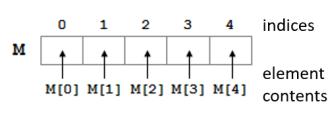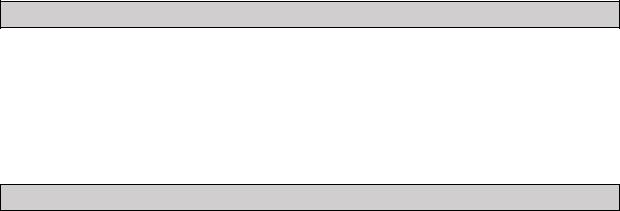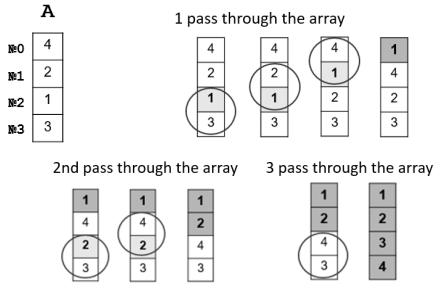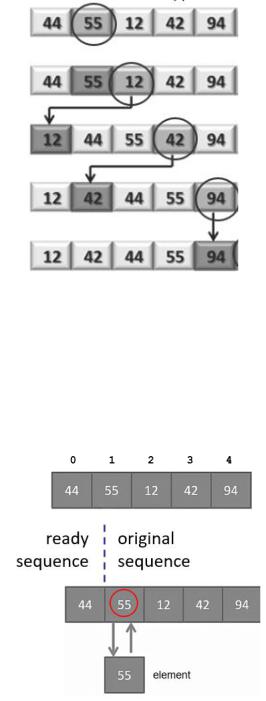
книги2 / Ilyin-Fundamentals-and-methodology-of-programming
.pdf
Let's try to understand the algorithm:
a)during the initial call F(1), “1” is printed, the condition is checked (true!) and entry into the 1st PB (i.e. in F(n + 1)), where the sent parameter n = 1 + 1 = 2;
b)when implementing the 1st RT call (i.e. F(2)), “2” is printed, the condition is checked (true!), and the entry is again into the 1st RT, where the sent parameter is already n = 2 + 1 = 3;
c)when F(3) is called, “3” is printed, the condition is checked (false!), and then there is a return (since after the condition there are no more operators) from the current RT to the place of the call with parameter n = 2. And immediately enters 2nd PB (i.e. F(n + 2)): 2 + 2 = 4). Similarly, the return from the 1st RT and the entrance to the 2nd RT are again implemented: (1 + 2) = 3.
On the screen we will see the following numbers: “1”, “2”, “3”, “4”, “3”, respectively, their sum is 13.
To make the algorithm work more clearly, let’s add another output operator after the condition. Detailed version:
#include <iostream> using namespace std ; void F(int n)
{
cout << " input n=" << n << "\n"; if (n < 3){
F(n + 1);
F(n + 2);
}
cout << " out put n=" << n << "\n";
}
int main(void){ F(1); system("pause");
}
The data output will be as follows (data related to the previous task is highlighted in gray):
input n=1
input n=2
input n=3
50

output n=3
input n=4
output n=4 output n=2
input n=3
output n=3 output n=1
Test questions and general tasks:
1.Define the concepts procedure and function. What is the difference between procedures and functions?
2.Which parameters are called formal and which actual?
3.Name the methods for passing parameters to subroutines.
4.What variables are called local?
5.What are recursive routines?
6.What is a stack and what role does it play in program execution?
7.General task. Develop an application that implements a procedure for finding the maximum value from two numbers and a function for finding the minimum value from two numbers.
8.General task. A positive integer is entered (no more than 255 10 , for example, 89 10 ) and converted into binary code (format the program code into a procedure), the sum of its digits is calculated (format the program code into a function).
9.General task. Write a function that “reverses” a number, i.e. returns a number with the digits in reverse order. Example: enter a natural number, 1234, after the revolution: 4321.
10.General task. Write a function that calculates the greatest common divisor (GCD) and least common multiple (LCD) of two natural numbers. Example: input numbers 10 and 15, output GCD(10,15)=5, LCM(10,15)=30.
51

SECTION 2. STATIC DATA STRUCTURES
TOPIC 5. ARRAYS AND ALGORITHMS FOR THEIR PROCESSING
In some cases, it is inconvenient to store a lot of the same type of data related to a specific subject area in ordinary variables. Therefore, they are combined into a group with a common name.
An array (for C / C ++) is a group of variables of the same type, located nearby in memory (in adjacent cells) and having a common name.
An array element has three characteristics (Fig. 2.1):
1)name (for example, M );
2)index – an integer that uniquely determines the location of the element in the array. A variable or an arithmetic expression of an integer type (for example, 0, 1, i , i +1, etc.) can also be used as an index ;
3)value – the actual value of the element (for example, M[0]).
Fig. 2.1. Numbering of array elements
Array declaration syntax: Type <name>[size] , for example, int M[5]. Array elements are numbered starting from zero: M[0], M[1], M[2], M[3], M[4]
It is more rational to declare static arrays using a constant:
const int N = 5; int M[N];
The above array declaration has the following purposes:
•appoint boolean name;
•determine the data type of elements;
•set the number of elements;
•allocate space in memory.
52

In C / C ++ it is important to define the initial values (initialization) of array elements.
If they are not specified, then the cells will contain “garbage” (foreign data in memory from previous programs).
Array initialization syntax:
Type <name>[size] = {list of values}
Example:
int M[5] = { 7, 3, -14, 9, 4 }; float F[3] = { 1.0, 2.0, 7.1 };
Processing array elements:
int i = 0; |
for(int i = 0; i < N; i++ ) |
while(i<N) |
{ |
{ |
// processing M[i] |
// processing M[i] |
} |
i++; |
|
} |
|
Let's look at typical array processing algorithms that are often found in program development practice.
Listing. Entering data into array elements from the keyboard
for (int i = 0; i < N; i++ )
{
cout << "M[" << i << "]="; cin >> M[i];
}
Listing. Printing the contents of array elements to the console
cout << "Array M:\n";
for (int i = 0; i < N; i++ ) cout << M[i] << " ";
53

Listing. Analysis of array elements (calculate the number and sum of array elements M, the values of which are from 25 to 40)
int count = 0, sum ma = 0; for (int i = 0; i < N; i++ ) if (M[i] > 25 && M[i] < 40 ) { count++;
sum ma += M[i];
}
Listing . Search maximum element array And his index
MAX = M[0]; nMAX = 0;
for (int i = 1; i < N; i++ ) if ( M[i] > MAX ) {
MAX = M[i]; nMAX = i;
}
cout << "M[" << nM AX << "]=" << M AX ;
Listing. Selection of elements by condition into a new array
int new_M[N];
for(int i = 0; i < N; i++) new_M[i]=0;
int count = 0; // internal counter of the number of selected elements
for(int i = 0; i < N; i++) if (M[i]>0) {
new_M[count]=M[i]; count++;
}
cout << " New array : ";
for (int i = 0; i < count; i++) cout<< new_M[i] <<" ";
Passing an array to subroutines
When passing an array to a subroutine, the address of the first element of the array is actually sent (that is, passing by reference, by a pointer to the zero element).
int SUM(int M[], ... ) // or int *M
{
...
}
54
Example: subroutine (function) to find the sum of array elements.
int SUM ( int M[], int N )
{
int sum = 0;
for (int i = 0; i < N; i++ ) sum += M[i];
return sum;
}
This is what a function call looks like:
void main()
{
int M[5], summa;
...
summa = SUM(M, 5);
...
}
Array sorting algorithms
Sorting is the process of rearranging the elements of a given set in a certain order, usually in order to facilitate the subsequent search for elements. In fact, this is a transformation of the original array into an array containing the same elements, but in descending (or ascending) order of values.
Sorting algorithms can be divided into two categories:
•simple, but ineffective in terms of speed for large amounts of data (“bubble method”, “selection method”, “insertion method”, etc.);
•complex, but speed-effective for large data arrays (“quick sort”, heap sort, etc.).
Bubble sorting (exchanges).
Let's consider the classic algorithm “ bubble method (sorting by exchanges) ”. The name of the method comes from the physical phenomenon of an air bubble floating in a vessel with water from the bottom to the top: the smallest (“lightest”) element moves upward (“floats”).
55

Fig. 2.2. Bubble sort (exchanges)
Iterating over elements starts from the end (bottom). In the inner loop, two adjacent elements are compared, and if they are placed incorrectly (the current one is greater than the lower one A[j] > A[j+1] ), then we swap them. In one pass of the inner loop through the array, one element (the smallest) is placed in the “right” place. At each subsequent pass of the inner loop, the number of processed elements decreases by one (the boundary i in the outer loop for already sorted elements). In the last iteration, the subarray of one element does not need to be sorted, so to sort N elements, no more than N-1 iterations of the outer loop are required.
In fact, to sort an array of N elements, you need N-1 passes (the outer loop specifies the number of passes through the array). In our example, for N = 4, 3 passes are needed.
for (int i=0; i<N-1; i++ ) // number of passes
for (int j=N-2; j>=i; j-- ) // inner loop from the end of the array
if ( A[j] > A[j+1] ) { temp = A[j]; A[j] = A[j+1]; A[j+1] = temp;
}
The complexity of the algorithm in this case is O(n 2 ), since there are two nested loops.
56

Sorting by selection (highlighting)
Selection sort involves selecting the smallest element in the array and moving it to the top, i.e. selecting the minimal element and placing it at the top (switching places with A[0]), from the remaining ones we again look for the minimal element and place it at a position lower relative to the top (switching places with A [1]), etc. In the figure, the underlined element is the smallest of the remaining ones.
Fig. 2.3. Sorting by selection
for( i = 0; i < N-1; i++ ) { nMin = i ;
for ( j = i+1; j < N; j++)
if( A[j] < A[nMin] ) nMin = j; // if the current element is less than the minimum, then remember its number
if( nMin != i ) { // if a new minimum is found
c = A[i]; // swap the i -th and the found new minimum with number nMin
A[i] = A[nMin]; A[nMin] = c;
}
}
In each iteration of the inner loop, we look for the number of the minimum element from the remaining ones and put it in the i th place. For example, in the first iteration we set the topmost element as the minimum ( nMin = i ) and in the loop from the next element we look for the one that will be smaller than it and remember its number ( nMin = j ). And then, if the new minimum has changed its index ( nMin != i ), i.e. does not remain equal to i , then we swap the i -th and the found new minimum with number nMin
.
So, the outer loop shifts the border of the already found minimal elements, in which the search goes to the penultimate element (up to N-1), since the last one will already be in its place. In the inner loop, the search for the minimum of the remaining elements is
57
carried out and it starts with j=i+1 ,since the i-th place already has the minimum one and we should not touch it.
There is an easier to understand option without checking the index change at the minimum value:
int min, n_min, j;
for (int i = 0; i < N – 1; i++)
{
min = A[i]; n_min = i;
for (j = i + 1; j < N; j++) if (A[j] < min)
{
min = A[j]; n_min = j;
}
A[n_min] = A[i]; // exchange via min A[i] = min;
}
The complexity of the algorithm in this case is O(n 2 ), since there are two nested loops.
Insertion (inclusion) sort.
Insertion sort involves conditionally dividing the elements of an array into two groups:
•“ready sequence” (where the leftmost element is initially placed and then sorted elements will be stored here);
•"original sequence" (remaining unsorted elements on the right).
At each step, the i-th element (circled) is inserted into the “appropriate place” in the finished sequence (on the left).
58

Fig. 2.4. Insertion sort
Let's take a closer look at this algorithm.
Let's look at the iterations of the outer loop. In the first iteration, we remember the initial element of the original sequence ( element = A[ 1 ]; ) and begin to compare it with all the elements of the finished part (in this case 44 < 55, so we do not make any rearrangements).
Fig. 2.5. Insertion sort. First iteration of outer loop
We go to the second iteration of the outer loop, where the finished part will already have two elements. And we do the same thing: we remember the next element of the original sequence ( element = A[ 2 ]; ) and begin to compare it with all the elements of the finished sequence (we compare element =12 with the values 44 and 55) and shift
59
